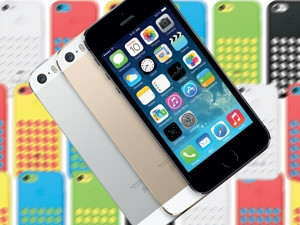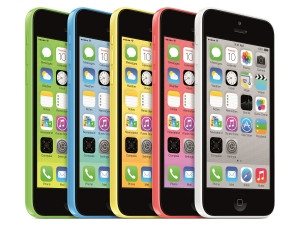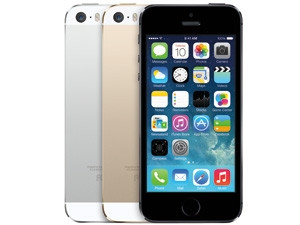
Apple's new iPhones are available to South African consumers as of today and, for the first time, the tech giant has included an "alternative" to its flagship smartphone in the form of an "unapologetically plastic", colourful range.
The iPhone 5C - the flagship 5S's slightly cheaper counterpart - has been positioned by the media, analysts and industry observers as Apple's answer for emerging markets, a cheaper alternative to the aspirational iPhone everyone knows. However, at just R1 500 cheaper than the 5S in SA, the viability of opting for one of the multi-coloured iPhones, as opposed to the premium product, has been questioned.
Arthur Goldstuck, MD of World Wide Worx, points out the 5C entered the local market at the same price point of Apple's premium smartphones in previous years. "The 5C looks like a mistake, to be honest. It can still only really appeal to the top end of the market and given that, it is hard to see why [Apple] would go to the trouble of creating a different device and price point that just puts pressure on the supply chain."
No cheap intentions
Apple CEO Tim Cook is cited in tech Web blog Boy Genius Report as saying Apple "never had an objective to sell a low-cost phone" that would compete with the cheap Android handsets that have been targeting emerging markets. Cook said in an interview that the goal with the iPhone 5C was "to sell a great phone and provide a great experience" at a lower cost.
iStore director Rutger-Jan van Spaandonk says Apple has never positioned the 5C as targeting emerging markets. "The phone is not meant to be an entry-level smartphone, but an entry-level Apple phone."
Van Spaandonk says it is unfair to compare the phone to its competitors on a feature-by-feature basis, saying this would be like comparing "a Kia to a Mercedes Benz, when both have steering wheels - yet the vehicles do not offer the same experience".
He says factors that determine the steep 5C price include the apps, the construction of the device, as well as its ecosystem. He notes feedback from local consumers so far indicates the handset is on par with global pricing when aspects such as customs and the exchange rate are taken into account.
Why the 5C?
The iPhone 5S 16GB is available for about R10 000, while the 5C equivalent is going for R8 500 - putting it firmly in the realm of other high-end smartphones like Apple's main rival, the Samsung Galaxy S4. The main differences between the two are in the hardware, processor speed and colours.

"So, why would a consumer who can afford Apple's premium model go for a slightly cheaper iPhone that has had to have certain elements compromised on?" question industry observers.
Goldstuck says, while the cheaper iPhone does appear to be a misstep on Apple's part, the company may have been trying to provide a lifestyle choice. Other than that, he says, consumers who were hoping to get their hands on the aspirational brand this time around will be disappointed.
Africa Analysis analyst Dobek Pater says the iPhone 5C is "a very expensive phone" and he is not sure what the benefits would be, considering it does not open up another market for the company. "At this price, this model seems to be in a similar price range as other iPhones."
Speculating as to Apple's intention - if not to serve emerging markets - Pater says: "It may fill a niche in the market (for example middle-class youngsters, who do not 'qualify' for a more expensive iPhone). [Or] it may be a way of releasing another model to make sure that iPhone gains a wider presence with a variety of models."
Africa Analysis analyst Ofentse Mopedi notes BlackBerry's Curve 8520 plugs the emerging market gap - and retails at a cost of $142 (about R1 450), almost six times less than the iPhone 5C.
Gartner says the price difference between the iPhone 5C and 5S is not enough in mature markets, where prices are skewed by operator subsidies, to drive users away from the top of the line model. The firm says the iPhone 4S - which now retails at R5 800 for the 8GB model - is more likely to be the volume driver at the low end, as the lack of subsidy in most markets leaves the iPhone 5C too highly priced to help drive further penetration.
Mike Sharman, owner of digital communications agency Retroviral, says in a South African context, the percentage price differential is not as large as it would be in the US, and the concept of a cheaper iPhone is not borne out. He says it does not make sense to have a product that is one level slightly cheaper.

Sharman notes it is not an entry-level smartphone and Apple is not targeting Africa, like some other manufacturers are doing. He says future growth will come from emerging markets.
It is almost as if Apple has created a second phone, but not a second market, says Sharman. He questions why someone would buy the 5C when the 4S is about half its cost and is still a good handset.
In addition, for R1 500 more, Sharman would rather opt for the added features and build of the 5S - like the fingerprint scanner and motion co-processor.
However, Sharman notes the 5C may gain traction in younger markets due to the colours it comes in: white, pink, yellow, blue and green.
Goldstuck says Apple is clearly trying to maintain its margins - a critical part of the company's profit. Despite criticism, he notes, Apple still remains one of the most profitable companies in the world.
"In fact, Apple and Samsung remain the only truly profitable smartphone companies in the world. A few other smartphone makers are making a comeback, though, and it will be interesting to see if Apple's premium pricing will provide another opportunity for brands that are bringing smartphones with features consumers want, at a cheaper price."
He mentions Sony, Huawei, Alcatel One Touch and Nokia as a few of the companies Apple's pricing strategy may give a window of opportunity.
At the end of the day, Apple will still see "absurd profits" and there remains much aspiration for the brand in SA, he notes. "A recent study we did among students in SA showed that 40% wanted their next smartphone to be an iPhone - but most would not be able to afford it."
Smartphone stats
Gartner's latest research notes smartphones now account for 55% of all mobile handsets sold globally in the third quarter of the year, the devices' highest share so far. In total, 455.6 million handsets were sold in the quarter.
"Sales of feature phones continued to decline and the decrease was more pronounced in markets where the average selling price (ASP) for feature phones was much closer to the ASP affordable smartphones," says Anshul Gupta, principal research analyst at Gartner. "In markets such as China and Latin America, demand for feature phones fell significantly as users rushed to replace their old models with smartphones."
Gartner analysts said global mobile phone sales are on pace to reach 1.81 billion units in 2013, a 3.4% increase from 2012.
Although Samsung's market share was flat in the quarter, it increased its lead over Apple, which reached 30.3 million new phones in the third quarter - a 23.2% gain year-on-year.
"While the arrival of the new iPhones 5S and 5C had a positive impact on overall sales, such impact could have been greater had they not started shipping late in the quarter. While we saw some inventory built up for the iPhone 5C, there was good demand for iPhone 5S with stock out in many markets," says Gupta.
GSMA, commenting on the back of Microsoft's purchase of Nokia, said the need for more affordable smartphones is a key priority for mobile operators in both developed and developing regions.
It says the wider availability of more affordable smartphones would not only attract high consumer demand (further boosting market share), but would also help operators to reduce subsidies and increase data revenues (in turn helping to preserve margins).
"Android is the de-facto operating system that encompasses a wide range of affordable smartphones that have fallen well under the sub-$150 price mark - a 'sweet spot' that Chinese OEMs in particular are focusing on," says GSMA.
Last month, the IDC said the mobile phone market will continue to experience steady growth, but the opportunity for ASP smartphones is ending. Growth will come from mid-tier smartphones in mature markets and low-end Android smartphones in emerging markets.
The overall mobile phone market is growing faster than previously expected, thanks to strong gains in emerging markets and the sub-$200 smartphone segment, it noted in September. IDC expects total smartphone shipments to reach 1.7 billion units in 2017.
iPhone 5C | iPhone 5S | Samsung S4 | BlackBerry Z10 | LG G2 | |
Price | R9 999 | R11 499 | R8 149 | R4 509 | R6 899 |
Storage | 32GB | 32GB | 32GB external upgradeable | 16GB external upgradeable | 16GB |
Display | 4" | 4" | 5" | 4.2" | 5.2" |
Size | 124.4x59.2x8.97mm | 123.8x58.6x7.6mm | 136.6x69.8x7.9mm | 130x65.6x9mm | 138.5x70.9x8.9mm |
Weight | 132g | 112g | 130g | 137.5g | 143 |
Colours | White, pink, yellow, blue, green | Grey, gold, silver | Black, white, blue | Black, white | Black, white |
Share